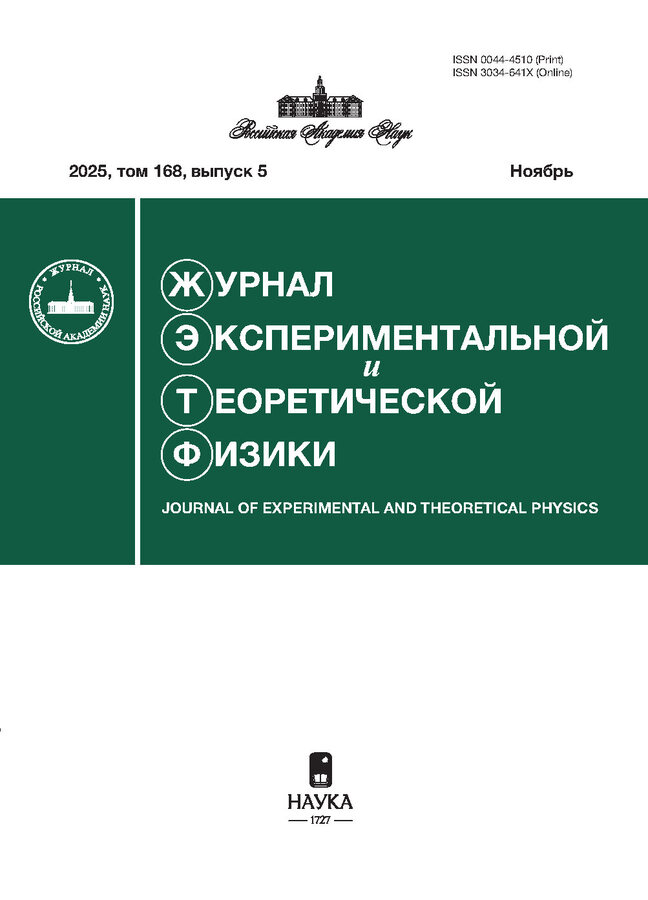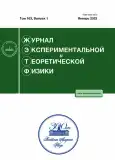Influence of Polymerization Conditions on Magnetic Properties of a Ferrocomposite
- Authors: Radushnov D.I1, Solov'eva A.Y.1, Elfimova E.A1
-
Affiliations:
- Ural Federal University
- Issue: Vol 163, No 1 (2023)
- Pages: 87-95
- Section: Articles
- URL: https://journals.rcsi.science/0044-4510/article/view/145479
- DOI: https://doi.org/10.31857/S004445102301011X
- EDN: https://elibrary.ru/NODOPA
- ID: 145479
Cite item
Full Text
Abstract
This paper is devoted to a theoretical study of the magnetic properties of an ensemble of single-domain interacting magnetic nanoparticles embedded in an immobile polymer matrix. This model is typical for the description of magnetically active polymer ferrocomposites widely used in industrial and biomedical applications. A ferrocomposite is assumed to be produced by carrier medium solidification in a ferrofluid in an external magnetic field hp at a polymerization temperature Tp; after carrier fluid solidification, the nanoparticles retain the spatial distribution and orientation of their easy magnetization axes that they had before carrier medium solidification. The contribution of interparticle dipole–dipole interactions to the static magnetization of a ferrocomposite as a function of the magnetic field strength h and polymerization field hp has been studied separately. The effects of the polymerization temperature and the size of magnetic nanoparticles on the magnetic properties of a ferrocomposite have been analyzed. The analytical expressions for the magnetization and initial magnetic susceptibility presented in the paper make it possible to predict the magnetic properties of a ferrocomposite as a function of its intrinsic characteristics and synthesis conditions, which is a theoretical basis for the production of ferrocomposites with a predetermined magnetic response in a given magnetic field.
About the authors
D. I Radushnov
Ural Federal University
Email: radushnovs@mail.ru
620000, Yekaterinburg, Russia
A. Yu Solov'eva
Ural Federal University
Email: radushnovs@mail.ru
620000, Yekaterinburg, Russia
E. A Elfimova
Ural Federal University
Author for correspondence.
Email: radushnovs@mail.ru
620000, Yekaterinburg, Russia
References
- T. Yoshida, N. B. Othman, T. Tsubaki et al., IEEE Trans. Magn. 48, 3788 (2012).
- D. Eberbeck, F. Wiekhorst, S. Wagner et al., Appl. Phys. Lett. 98, 182502 (2011).
- A. G. Kolhatkar, A. C. Jamison, D. Litvinov et al., Int. J. Mol. Sci. 14, 15977 (2013).
- L. Rodriguez-Arco, I. A. Rodriguez, V. Carriel et al., Nanoscale 8, 8138 (2016)
- T. I. Becker, Y. L. Raikher, O. V. Stolbov et al., Smart Mater. Struct. 26, 095035 (2017).
- L. A. Makarova, T. A. Nadzharyan, Yu. A. Alekhina et al., Smart Mater. Struct. 26, 095054 (2017).
- T. Yoshida, Y. Matsugi, N. Tsujimura et al., J. Magn. Magn. Mater. 427, 162 (2017).
- N. E. Kazantseva, I. S. Smolkova, V. Babayan et al., Nanomaterials 11, 3402 (2021).
- F. Campos, A. B. Bonhome-Espinosa, R. Carmona et al., Mater. Sci. Eng., C 118,111476 (2021).
- A. Sharma, D. Mangla, H. Shehnaz et al., J. Environ. Manage. 306, 114483 (2022).
- S. Behrens, Nanoscale 3, 877 (2011).
- A. Dobroserdova, M. Schu�umann, D. Borin et al., Soft Matter. 18, 496 (2022).
- B. Elder, R. Neupane, E. Tokita et al., Adv. Mater. 32, 1907142 (2020).
- G. V. Stepanov, D. Y. Borin, A. V. Bakhtiiarov et al., Phys. Sci. Rev. (2020).
- R. I. Baron, G. Biliuta, V. Socoliuc et al., Polymers 13, 1693 (2021).
- T. Krasia-Christoforou, V. Socoliuc, K. D. Knudsen et al., Nanomaterials 10, 2178 (2020).
- N. Y. Mikhailin, Y. M. Galperin, V. I. Kozub et al., JETP 128, 761 (2019).
- G. Filipcsei, I. Csetneki, A. Szil'aagyi et al., Adv. Polym. Sci. 206, 137 (2007).
- S. Abramchuk, E. Kramarenko, G. Stepanov et al., Polym. Adv. Technol. 18, 883 (2007).
- M. Deu hard, D. Eberbeck, P. Hietschold et al., PCCP 21, 14654 (2019).
- S. Ikhaddalene, F. Zibouche, A. Ponton et al., Period. Polytech. Chem. Eng. 65, 378 (2021).
- R. E. Rosensweig, Ferrohydrodynamics, Courier Corporation (2013).
- E. A. El mova and A. O. Ivanov, JETP 111, 146 (2010).
- Yu. E. Nekhoroshkova, O. A. Goldina, P. J. Camp et al., JETP 118, 442-456 (2014).
- A. L. Elrefai, T. Sasayama, T. Yoshida et al., IEEE Trans. Magn. 57, 9201021 (2021).
- D. Borin, G. Stepanov, A. Musikhin et al., EPJ ST (2022).
- D. Borin, Philos. Trans. R. Soc. A: Mathematical, Physical and Engineering Sciences 378, 0256 (2020).
- Yu. L. Raikher, J. Magn. Magn. Mater. 39, 11 (1983).
- A. Yu. Zubarev, Phys. Rev. E 98, 032610 (2018).
- J. Dieckho, D. Eberbeck, M. Schilling et al., J. Appl. Phys. 119, 043903 (2016).
- E. A. El mova, L. Y. Iskakova, A. Y. Solovyova et al., Phys. Rev. E 104, 054616 (2021).
- E. A. El mova, A. O. Ivanov, and P. J. Camp, Nanoscale 11, 21834 (2019).
- K. Enpuku and T. Yoshida, AIP Adv. 11, 125123 (2021).
- S. Draack, T. Viereck, F. Nording et al., J. Magn. Magn. Mater. 474, 570 (2019).
- P. M. D'ejardinn, J. Appl. Phys. 110, 113921 (2011).
- A. V. Ambarov, V. S. Zverev, and E. A. El mova, J. Magn. Magn. Mater. 497, 166010 (2020).
- A. V. Ambarov, V. S. Zverev, and E. A. El mova, Modell. Simul. Mater. Sci. Eng. 28, 085009 (2020).
- A. L. Elrefai, K. Enpuku, and T. Yoshida, J. Appl. Phys. 129, 093905 (2021).
- A. Yu. Solovyova, E. A. El mova, and A. O. Ivanov, Phys. Rev. E 104, 064616 (2021).
- D. I. Radushnov, A. Yu. Solovyova, and E. A. El mova, Nanoscale (2022).
- A. F. Pshenichnikov and A. V. Lebedev, J. Chem. Phys. 121, 5455 (2004).
- A. F. Pshenichnikov and A. V. Lebedev, Colloid J. 67, 189 (2005).
- A. V. Lebedev, Colloid J. 72, 815 (2010).
- A. V. Lebedev, Colloid J. 76, 334 (2014).
Supplementary files










